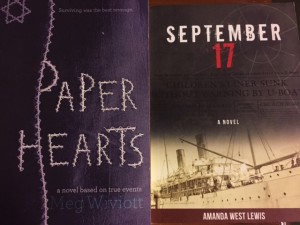 Wherever they live, children are all too often the innocent victims of war. Millions of children perished during World War II, on all sides of the conflict, from Jewish and Roma children killed in the Holocaust to children whose homes were bombed and those forced into combat in Germany’s desperate last stand. Two recently published books for teen readers, Amanda West Lewis’s September 17 (Red Deer Press, 2013) and Meg Wiviott’s Paper Hearts (Simon & Schuster, 2015) are based on real-life stories of children and teens who survived while so many of their family members and friends did not. Through extensive research and careful fictionalizing, both authors bring these stories to life to reaffirm the power of friendship and the resiliency and heroism of young people.
Wherever they live, children are all too often the innocent victims of war. Millions of children perished during World War II, on all sides of the conflict, from Jewish and Roma children killed in the Holocaust to children whose homes were bombed and those forced into combat in Germany’s desperate last stand. Two recently published books for teen readers, Amanda West Lewis’s September 17 (Red Deer Press, 2013) and Meg Wiviott’s Paper Hearts (Simon & Schuster, 2015) are based on real-life stories of children and teens who survived while so many of their family members and friends did not. Through extensive research and careful fictionalizing, both authors bring these stories to life to reaffirm the power of friendship and the resiliency and heroism of young people.
This month marks the 75th anniversary of the German torpedoing of the City of Benares, a civilian vessel that carried more than 400 passengers, among them 90 British children under the age of fifteen to be sent to safety in Canada. These children, most of them from poor families, had already survived the bombing of their neighborhoods and scarcity of food. In the novel, Ken Sparks’s unemployed parents have applied for him to leave in part so they can rent out his room. At the last minute, bookish Bess Walder persuades her parents to let her beloved younger brother, Louis, accompany her on the journey. Sonia Bech travels with her mother and two siblings in first class, among the few who are paying passengers rather than government-funded evacuees. Four days after the ship’s departure and in the middle of a storm, Ken, Bess, and Sonia cling to life in rickety lifeboats following the German U-Boat attack. Bess and her new friend Beth keep each other awake and alive holding onto a capsized boat in freezing waters. The rescue ship misses Ken’s lifeboat, and he and several dozen others sail for ten days through violent storms with almost no food or water.
In the end, only 13 or the 90 “seavacuees” survive, along with seven of the ten young paid passengers. September 17 describes the events through the eyes of three of the survivors. Their heroism is inspiring, but the children also put faces to war’s cost. They endure harrowing events and witness the death of other children, including friends and siblings of friends. The chapters alternate the perspectives of Ken, Bess, and Sonia, allowing readers to see how children from disparate places in England and disparate backgrounds were thrown together on the City of Benares and what happened in the fateful moments, hours, and days after the German torpedo blew the ship apart.
The themes of heroism, resilience, and hope are central as well to Wiviott’s brand-new verse novel. Paper Hearts is based on the Heart of Auschwitz, which Fania Landau’s friends made in secret at the death camp for her birthday. Fania manages to keep the heart intact through a harrowing march in the final weeks of the war, through snow, rain, mud, and brutal, terrified German soldiers, many of whom at this point were no older than the teenage girls.
In sections that alternate between Fania’s point of view and that of Zlatka Sznaiderhauz, another Polish Jewish girl that she meets in Auschwitz, readers learn of the two girls’ families and how they come to be friends. Zlatka was deported with the rest of her family while Fania’s family sent her to a non-Jewish village because she looked “Aryan.” Yet Fania was betrayed, along with three other hidden girls. In Auschwitz, Fania and the other girls stick together, and their solidarity keeps them alive while many of the other prisoners take an “every woman for herself” approach that leaves them alone and vulnerable. When the girls see Zlatka by herself after the death of her sister, they bring her into the fold. Eventually, the circle of friendship and solidarity grows larger through Fania’s leadership and example, the sacrifice of other prisoners, and a little bit of luck.
Paper Hearts adds significantly to the literature for young people about the Holocaust, not only in illuminating the story behind the Heart of Auschwitz but also in showing how friendship, trust, and solidarity can overcome hatred and violence. Like Bess and Beth in September 17, Fania, Zlatka, and their friends demonstrate the heroism of young women who band together, maintaining their humanity under the most inhuman circumstances by looking out for each other.